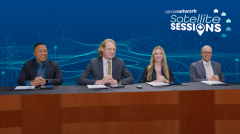
Determining Transplant Ineligibility in Newly Diagnosed Multiple Myeloma
Focused discussion on factors that aid in determining transplant ineligibility when a patient presents with newly diagnosed multiple myeloma.
Episodes in this series

Transcript:
Andrew P. Dalovisio, MD: I think that’s a good segue into the transplant-ineligible setting, where I think there’s also been a lot of exciting advancements made. I think “transplant ineligible” is, in a lot of ways, in the eye of the beholder. When you assess a patient for frailty or even whether you’re going to refer this patient for transplant, do you use a formal system or just eyeball them?
Kelly Pippin, MD: I think we all do the “walk in the room and look at the patient” test as the initial assessment. I think we all look to see if they’re in a wheelchair or have a cane resting against the door. I think the next thing we see is when you’re talking to them, are they engaged in the exam? Do they answer their own questions, or do they defer to a family member in the room to answer everything? The next step would be if they’re answering all my questions, then I start to go down into the Karnofsky-type questions to see if they’re performing their ADLs [activities of daily living]. But I think most of us have a pretty good hunch when we walk in the door where they are just by the way they’re sitting, who’s with them, and that sort of thing. I think I do go down a Karnofsky-type questionnaire, but it’s probably after I’ve almost made my decision, in a way.
Thomas Atkinson, MD: That sounds a lot like how I practice. You almost know when you first meet somebody if they’re going to be a good candidate or not, just on the overall gestalt of the patient. But every so often that initial impression can turn out to be wrong. So you always have to leave some space in your mind to be convinced one way or the other by objective data.
Ryan P. Griffin, MD: One of the issues with the scoring systems is that you can call someone frail pretty quickly. If you’re 76, and if your ECOG [performance status] is 1, well, then, you’re frail. So, most of the time, I almost let our transplant team make the big determinations.
Ernest C. Quintin, MD: It’s [interesting] you bring up the wheelchair thing. I actually just had this conversation today with somebody. I usually see them, and if they’re in the wheelchair, I ask them, “Why are you in the wheelchair?” And then they’ll say, “Oh, well it’s just my hip doesn’t really feel as good, and things like that.” And it’s almost like you’re trying… [CROSSTALK]
Thomas Atkinson, MD: [CROSSTALK] …You’re coming away from the parking garage.
Ernest C. Quintin, MD: Yes, exactly. Exactly. Well, it depends on the parking garage. But it’s almost like I’m looking for a reason for you to be healthy enough so I can at least get you in front of the transplant.
Kelly Pippin, MD: And how many people have come to you 5 days after they were discharged from the hospital, and they started out in a wheelchair, [so] you made this assumption about their functional status? You give them 3 cycles of chemotherapy, you get them in better shape, and they walk in the next time. And then you have this whole different opinion and you’re like, “Oh, gosh, I kind of made a quick judgment there.”
Ernest C. Quintin, MD: So it’s as Ryan said, let the transplanter tell you; they know more than anyone else… [CROSSTALK]
Kelly Pippin, MD: Yeah. Exactly.
Andrew P. Dalovisio, MD: Especially for… [CROSSTALK]
Thomas Atkinson, MD That’s always been my rule of thumb. If I even think there’s a possibility in heaven, I’ll say, “You know what, let Andy figure it out.”
Ernest C. Quintin, MD But I think that’s why we’ve all basically been trained to know that that deep response is really what you’re going for.
Andrew P. Dalovisio, MD: Yes. And I don’t want to burst the mystique of the transplant clinic, but we don’t do much more than what you guys are talking about. [LAUGHTER] It’s me walking in the door and saying yes or no. I mean, there are some scenarios, like [with a patient who is aged 75 or older] where you can still technically do a transplant. Where I may compute this, I may ask them to get up and walk the hall and get up out of a chair. But I would say it’s fairly unscientific outside of things like echocardiograms and pulmonary function tests that you can numerically assess.
Transcript edited for clarity.
Newsletter
Stay up to date on recent advances in the multidisciplinary approach to cancer.



















































































